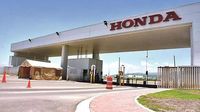In a recent development, Marcelo Ebrard, Mexico's Secretary of Economy, has firmly stated that Honda will not be relocating its automobile production from Mexico to the United States, despite reports suggesting otherwise. On April 15, 2025, Ebrard took to social media to clarify that Honda executives in Mexico confirmed there would be "no modification" to their production plans in the country.
This clarification comes in response to a report from the Japanese media outlet Nikkei, which suggested that Honda Motor Co. was contemplating moving part of its production from Mexico and Canada to the U.S. This potential shift was reportedly in reaction to the 25 percent tariffs imposed by former President Donald Trump on imported vehicles and auto parts that are not manufactured in the U.S.
According to Nikkei, Honda aims to increase its production in the United States by up to 30 percent over the next two to three years, which would allow the company to manufacture 90 percent of the vehicles sold in the U.S. locally. Ebrard's statement directly contradicts this report, emphasizing that Honda's leadership assured him of their commitment to maintaining operations in Mexico.
In February, Trump announced his intention to impose punitive tariffs on Mexico and Canada, claiming they were not doing enough to combat irregular migration and the trafficking of fentanyl. Although he temporarily froze the application of these tariffs in March for goods covered under the United States-Mexico-Canada Agreement (USMCA), the automotive sector has been on alert since the announcement.
On April 2, Trump introduced what he termed "reciprocal tariffs," which involved general rates of 10 percent on various imports, but notably, Mexico and Canada were excluded from this list of countries facing additional tariffs. This has created a complex landscape for automakers like Honda, which heavily relies on North American production.
Despite the uncertainty, Honda has reaffirmed its position. Ebrard noted that the company is currently planning to move production of its CR-V SUV from Canada to the U.S. and the HR-V SUV from Mexico to the U.S. These moves are part of Honda's broader strategy to adapt to changing market conditions and tariff implications.
As the largest supplier of automobiles to the U.S. market, Mexico's automotive industry plays a crucial role in the economic relationship between the two nations. The Mexican government is actively negotiating favorable tariff conditions with the U.S. to ensure that the integration of automotive parts remains beneficial for both countries.
According to the Mexican Association of Automotive Distributors (AMDA), while U.S. tariffs on Mexican auto exports are set at 25 percent, a new methodology will be developed to reduce these rates. This approach aims to discount the value of U.S.-origin parts integrated into exported vehicles, potentially lowering the effective tariff to about 15 percent.
In a recent statement, Ebrard mentioned that Mexico is negotiating an "automotive discount" on the tariff rates imposed by the U.S., dependent on the model of the vehicle and the integration of U.S. parts. He indicated that discussions regarding the review of the USMCA would commence in the second half of 2025, focusing initially on steel and aluminum tariffs, as well as automotive tariffs.
Last year, the U.S. market accounted for nearly 40 percent of Honda's global sales, with the company selling approximately 1.4 million vehicles, including Acura models, in the U.S. Of these, about two-fifths were imported from Canada or Mexico. The strong demand for Honda vehicles in the U.S. has prompted the automaker to consider expanding its workforce in the U.S. to support increased production.
Reports indicate that Honda is contemplating hiring additional U.S. workers, which would allow the company to operate on three shifts instead of two and extend production into the weekends. This strategy aims to enhance production capacity amid evolving market dynamics and tariff challenges.
As the automotive industry navigates these turbulent times, the relationship between Mexico and the U.S. remains critical. Ebrard's assurance that Honda will maintain its production in Mexico reflects the ongoing efforts to solidify economic ties and adapt to the changing landscape of international trade.
In conclusion, while the automotive sector faces significant challenges from tariff policies, the commitment of companies like Honda to their production plans in Mexico is a positive sign for the industry. As negotiations continue and the market evolves, the focus will remain on maintaining a robust and integrated automotive supply chain across North America.








